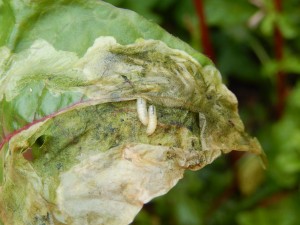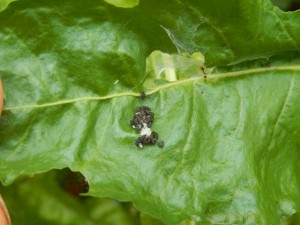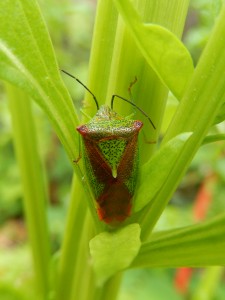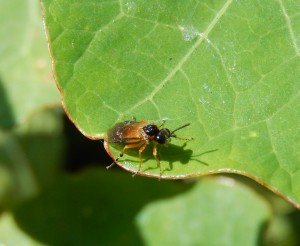
Well, I usually try to take a pretty picture to start off a posting, but this one certainly doesn’t qualify. These leaf miners grow entirely inside a leaf, in this case of Spinach Beet. As you can see, as they grow they tunnel around below the leaf’s upper epidermis, which is a translucent layer of cells, leaving it intact to provide themselves with a ready-made cover.
Underneath that sheet, a healthy leaf contains a thick green set of palisade cells in one or several layers. These are the leaf’s (and the plant’s) factory, as they are full of chloroplasts, coloured green to absorb light: they synthesize the sugars on which life depends.
Not many people would want to eat this leaf, once the leaf miner larvae – mostly moths – have been at work. The palisade layers are entirely and efficiently destroyed wherever the insects have been. All that remains is an air-space and some dark frass: all, that is, but for the plump whitish cylindrical bodies of the larvae themselves.

Also nesting on the spinach are some ladybirds. These have incomplete metamorphosis, the young being able to walk as well as eat from their first stage or instar. Each time they moult they change in appearance as well as in size. They mainly eat aphids, troublesome pests of many crops, so they are useful to gardeners and to any farmers who don’t want to use insecticides.

This shield bug, seen here in close-up, may look conspicuous enough, but that is the camera’s view. The insect is actually rather well camouflaged, and it generally hides under a leaf where it is in some shadow. The camouflage consists first of a general colour resemblance to its background, with its overall grass-green coloration; and as seen here, it is also disruptively patterned, with the reddish brown of its wings tending to break up its outline. Perhaps it is also somewhat countershaded, with dots stippling its back. Bugs suck plant juices, and their larvae can be quite destructive, but they never seem to do much harm to the spinach.
There are also some green caterpillars, excellently camouflaged with a pale cream stripe all along their sides. (It might be the Hebrew Character moth.) You might expect this to be conspicuous, but it seems to be a classic piece of disruptive coloration: the stripe appears like a sun-glint specular highlight on the shiny crumpled surface of the spinach leaf, rather than part of a solid, round-bodied animal.

A pest I know is there is the Gooseberry Sawfly. There are numerous sawflies in the garden right now, but they are all flying around the Nasturtiums, nowhere near the gooseberry bush. However… plenty of the lower leaves of the gooseberry are badly damaged by sawfly larvae, some eaten right down to the petiole, pathetic little stumps with a few short branching veins all that remains of once green foliage. What to do about it? This isn’t a how-to-garden site, but inspect your gooseberry bush(es) regularly, looking especially at the lower leaves to see if they’re being eaten. If some are, check the edges for caterpillars. If you find any, spray the bush after sunset on a dry still evening (to avoid killing the bees that are pollinating your fruit) with a garden insecticide.
Five minutes of careful searching of half-eaten gooseberry leaves failed to reveal a single larva. The cause in this case is not so much camouflage as the incredibly intense predation by Blue Tits (and Great Tits). I estimate these little birds are a hundred times better at finding caterpillars than I am. They have the advantage of getting in close – they must be able to focus down to a few centimetres, their small eyes acting as short-focus wide-angle lenses – and of being able to perch anywhere in a bush. They also get up very early, and know instinctively exactly what food looks like: small well-camouflaged caterpillars on the undersides and edges of leaves.
Zoologists suppose that birds have a ‘search image’ of the prey they are hunting: perhaps this is much the same idea as the training images that computer scientists use to teach their neural nets to recognise patterns such as faces. Once you have such an image in your brain, you almost instantly recognise your target when it appears. To give a small illustration, I remember when I had a small motorbike, I always saw bike shops everywhere; now I never notice them. My eye was attuned, like a Blue Tit’s to a caterpillar.
